 android.support.v4.app.Fragment
android.support.v4.app.Fragment
 android.support.v4.app.ListFragment
android.support.v4.app.ListFragment
|
||||||||||
| PREV CLASS NEXT CLASS | FRAMES NO FRAMES | |||||||||
| SUMMARY: NESTED | FIELD | CONSTR | METHOD | DETAIL: FIELD | CONSTR | METHOD | |||||||||
java.lang.Objectandroid.support.v4.app.Fragment
android.support.v4.app.ListFragment
public class ListFragment

Static library support version of the framework's ListFragment.
Used to write apps that run on platforms prior to Android 3.0. When running
on Android 3.0 or above, this implementation is still used; it does not try
to switch to the framework's implementation. See the framework SDK
documentation for a class overview.
| Nested Class Summary |
|---|
| Nested classes/interfaces inherited from class android.support.v4.app.Fragment |
|---|
Fragment.InstantiationException, Fragment.SavedState |
| Constructor Summary | |
|---|---|
ListFragment()
|
|
| Method Summary | |
|---|---|
android.widget.ListAdapter |
getListAdapter()
Get the ListAdapter associated with this activity's ListView. |
android.widget.ListView |
getListView()
Get the activity's list view widget. |
long |
getSelectedItemId()
Get the cursor row ID of the currently selected list item. |
int |
getSelectedItemPosition()
Get the position of the currently selected list item. |
android.view.View |
onCreateView(android.view.LayoutInflater inflater,
android.view.ViewGroup container,
android.os.Bundle savedInstanceState)
Provide default implementation to return a simple list view. |
void |
onDestroyView()
Detach from list view. |
void |
onListItemClick(android.widget.ListView l,
android.view.View v,
int position,
long id)
This method will be called when an item in the list is selected. |
void |
onViewCreated(android.view.View view,
android.os.Bundle savedInstanceState)
Attach to list view once the view hierarchy has been created. |
void |
setEmptyText(CharSequence text)
The default content for a ListFragment has a TextView that can be shown when the list is empty. |
void |
setListAdapter(android.widget.ListAdapter adapter)
Provide the cursor for the list view. |
void |
setListShown(boolean shown)
Control whether the list is being displayed. |
void |
setListShownNoAnimation(boolean shown)
Like setListShown(boolean), but no animation is used when
transitioning from the previous state. |
void |
setSelection(int position)
Set the currently selected list item to the specified position with the adapter's data |
| Methods inherited from class java.lang.Object |
|---|
clone, finalize, getClass, notify, notifyAll, wait, wait, wait |
| Constructor Detail |
|---|
public ListFragment()
| Method Detail |
|---|
public android.view.View onCreateView(android.view.LayoutInflater inflater,
android.view.ViewGroup container,
android.os.Bundle savedInstanceState)
android.R.id.list and can optionally
have a sibling view id android.R.id.empty
that is to be shown when the list is empty.
If you are overriding this method with your own custom content,
consider including the standard layout R.layout.list_content
in your layout file, so that you continue to retain all of the standard
behavior of ListFragment. In particular, this is currently the only
way to have the built-in indeterminant progress state be shown.
onCreateView in class Fragmentinflater - The LayoutInflater object that can be used to inflate
any views in the fragment,container - If non-null, this is the parent view that the fragment's
UI should be attached to. The fragment should not add the view itself,
but this can be used to generate the LayoutParams of the view.savedInstanceState - If non-null, this fragment is being re-constructed
from a previous saved state as given here.
public void onViewCreated(android.view.View view,
android.os.Bundle savedInstanceState)
onViewCreated in class Fragmentview - The View returned by Fragment.onCreateView(LayoutInflater, ViewGroup, Bundle).savedInstanceState - If non-null, this fragment is being re-constructed
from a previous saved state as given here.public void onDestroyView()
onDestroyView in class Fragment
public void onListItemClick(android.widget.ListView l,
android.view.View v,
int position,
long id)
l - The ListView where the click happenedv - The view that was clicked within the ListViewposition - The position of the view in the listid - The row id of the item that was clickedpublic void setListAdapter(android.widget.ListAdapter adapter)
public void setSelection(int position)
position - public int getSelectedItemPosition()
public long getSelectedItemId()
public android.widget.ListView getListView()
public void setEmptyText(CharSequence text)
public void setListShown(boolean shown)
Applications do not normally need to use this themselves. The default
behavior of ListFragment is to start with the list not being shown, only
showing it once an adapter is given with setListAdapter(ListAdapter).
If the list at that point had not been shown, when it does get shown
it will be do without the user ever seeing the hidden state.
shown - If true, the list view is shown; if false, the progress
indicator. The initial value is true.public void setListShownNoAnimation(boolean shown)
setListShown(boolean), but no animation is used when
transitioning from the previous state.
public android.widget.ListAdapter getListAdapter()
|
||||||||||
| PREV CLASS NEXT CLASS | FRAMES NO FRAMES | |||||||||
| SUMMARY: NESTED | FIELD | CONSTR | METHOD | DETAIL: FIELD | CONSTR | METHOD | |||||||||